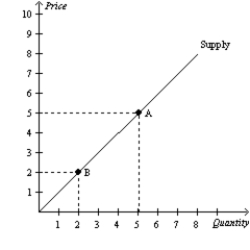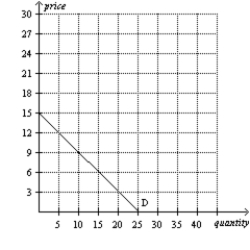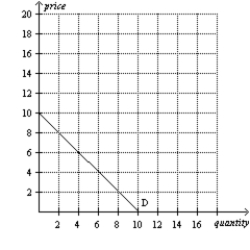Correct Answer

verified
Correct Answer
verified
Multiple Choice
Table 4-3
 -Refer to Table 4-3. If these are the only four buyers in the market, then when the price increases from $1.00 to $1.50, the market quantity demanded
-Refer to Table 4-3. If these are the only four buyers in the market, then when the price increases from $1.00 to $1.50, the market quantity demanded
A) decreases by 1.75 units.
B) increases by 2 units.
C) decreases by 7 units.
D) decreases by 24 units.
Correct Answer

verified
Correct Answer
verified
Multiple Choice
Table 4-6
 -Refer to Table 4-6. If these are the only four sellers in the market, then the market quantity supplied at a price of $10 is
-Refer to Table 4-6. If these are the only four sellers in the market, then the market quantity supplied at a price of $10 is
A) 3 units.
B) 11 units.
C) 25 units.
D) 44 units.
Correct Answer

verified
Correct Answer
verified
Multiple Choice
A group of buyers and sellers of a particular good or service is called a(n)
A) coalition.
B) economy.
C) market.
D) competition.
Correct Answer

verified
Correct Answer
verified
Multiple Choice
Table 4-1
 -Refer to Table 4-1. If the market consists of Michelle, Laura, and Hillary and the price falls by $1, the quantity demanded in the market increases by
-Refer to Table 4-1. If the market consists of Michelle, Laura, and Hillary and the price falls by $1, the quantity demanded in the market increases by
A) 2 units.
B) 3 units.
C) 4 units.
D) 5 units.
Correct Answer

verified
Correct Answer
verified
Multiple Choice
Suppose the United States had a short-term shortage of farmers. Which mechanisms would adjust to remove the shortage?
A) The government would provide tax incentives to encourage people to become farmers.
B) The government would subsidize the production of food.
C) The prices of food and the wages of farmers would adjust.
D) There are no mechanisms to remove the shortage.
Correct Answer

verified
Correct Answer
verified
Multiple Choice
The line that relates the price of a good and the quantity supplied of that good is called the supply
A) schedule, and it usually slopes upward.
B) schedule, and it usually slopes downward.
C) curve, and it usually slopes upward.
D) curve, and it usually slopes downward.
Correct Answer

verified
Correct Answer
verified
Multiple Choice
Table 4-3
 -Refer to Table 4-3. If these are the only four buyers in the market, then the market quantity demanded at a price of $1 is
-Refer to Table 4-3. If these are the only four buyers in the market, then the market quantity demanded at a price of $1 is
A) 4 units.
B) 7.75 units.
C) 14 units.
D) 31 units.
Correct Answer

verified
Correct Answer
verified
Multiple Choice
Which of the following would most likely serve as an example of a monopoly?
A) a restaurant in a large city
B) a dry cleaners in a large city
C) a local gas station
D) a local electrical company
Correct Answer

verified
Correct Answer
verified
Multiple Choice
Today, producers changed their expectations about the future. This change
A) can cause a movement along a supply curve.
B) can affect future supply, but not today's supply.
C) can affect today's supply.
D) cannot affect either today's supply or future supply.
Correct Answer

verified
Correct Answer
verified
Multiple Choice
Equilibrium price must increase when demand
A) increases and supply does not change, when demand does not change and supply decreases, and when demand decreases and supply increases simultaneously.
B) increases and supply does not change, when demand does not change and supply decreases, and when demand increases and supply decreases simultaneously.
C) decreases and supply does not change, when demand does not change and supply increases, and when demand decreases and supply increases simultaneously.
D) decreases and supply does not change, when demand does not change and supply increases, and when demand increases and supply decreases simultaneously.
Correct Answer

verified
Correct Answer
verified
Multiple Choice
Suppose that Amanda receives a pay increase. We would expect
A) to observe Amanda moving down and to the right along her given demand curve.
B) Amanda's demand for inferior goods to decrease.
C) Amanda's demand for each of two goods that are complements to increase.
D) Amanda's demand for normal goods to decrease.
Correct Answer

verified
Correct Answer
verified
Multiple Choice
In a market economy, supply and demand determine
A) both the quantity of each good produced and the price at which it is sold.
B) the quantity of each good produced but not the price at which it is sold.
C) the price at which each good is sold but not the quantity of each good produced.
D) neither the quantity of each good produced nor the price at which it is sold.
Correct Answer

verified
Correct Answer
verified
Multiple Choice
An increase in quantity demanded
A) results in a movement downward and to the right along a demand curve.
B) results in a movement upward and to the left along a demand curve.
C) shifts the demand curve to the left.
D) shifts the demand curve to the right.
Correct Answer

verified
Correct Answer
verified
Multiple Choice
Which of the following is not held constant in a demand schedule?
A) income
B) tastes
C) price
D) expectations
Correct Answer

verified
Correct Answer
verified
Multiple Choice
Figure 4-10  -Refer to Figure 4-10. The movement from Point A to Point B represents a(n)
-Refer to Figure 4-10. The movement from Point A to Point B represents a(n)
A) increase in the price.
B) decrease in the quantity supplied.
C) shift in the supply curve.
D) Both a and b are correct.
Correct Answer

verified
Correct Answer
verified
Multiple Choice
Figure 4-3
Consumer 1 Consumer 2

 -Refer to Figure 4-3. If these are the only two consumers in the market, then the market quantity demanded at a price of $15 is
-Refer to Figure 4-3. If these are the only two consumers in the market, then the market quantity demanded at a price of $15 is
A) 0 units.
B) 10 units.
C) 15 units.
D) 25 units.
Correct Answer

verified
Correct Answer
verified
True/False
A decrease in demand will cause a decrease in price, which will cause a decrease in supply.
Correct Answer

verified
Correct Answer
verified
Multiple Choice
In a market economy,
A) supply determines demand and demand, in turn, determines prices.
B) demand determines supply and supply, in turn, determines prices.
C) the allocation of scarce resources determines prices and prices, in turn, determine supply and demand.
D) supply and demand determine prices and prices, in turn, allocate the economy's scarce resources.
Correct Answer

verified
Correct Answer
verified
Multiple Choice
Table 4-12
A country club usually only allows members to purchase tickets for its celebrity golf tournament, but the club is considering allowing non-members to purchase tickets this year. The demand and supply schedules are as follows:
 -Refer to Table 4-12. If both members and non-members are allowed to purchase tickets to this year's celebrity golf tournament and the country club sets the ticket price at $30, then there will be
-Refer to Table 4-12. If both members and non-members are allowed to purchase tickets to this year's celebrity golf tournament and the country club sets the ticket price at $30, then there will be
A) a shortage of 300 tickets.
B) a surplus of 300 tickets.
C) 600 tickets sold.
D) 600 tickets unsold.
Correct Answer

verified
Correct Answer
verified
Showing 421 - 440 of 698
Related Exams